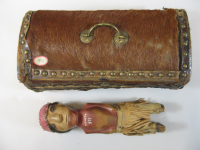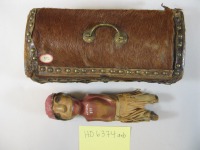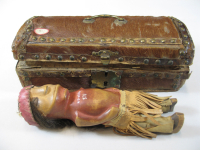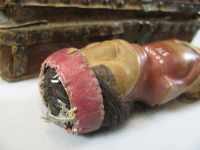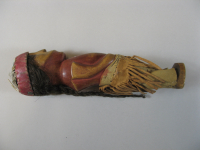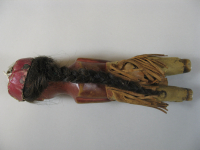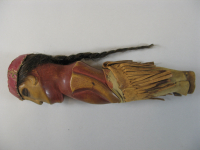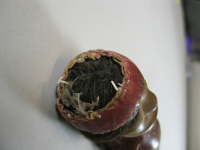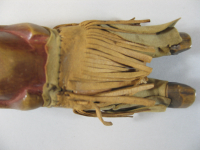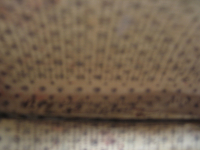figurine with chest
figurine with chest
figurine with chest
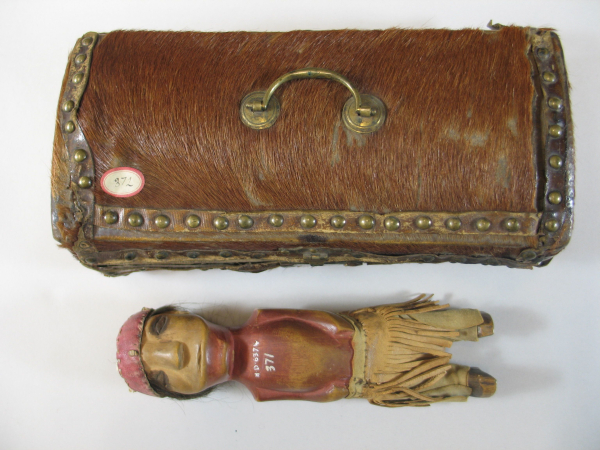
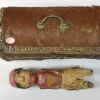
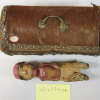
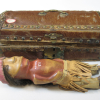
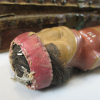
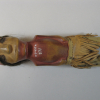


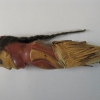
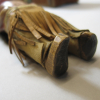
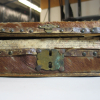
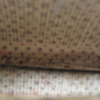
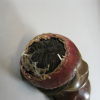
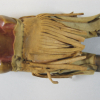
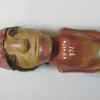
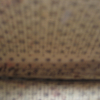
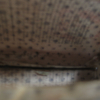
Odawa figurine and chest from Walpole Island. Wooden figurine is painted red on torso, chin, and back of head, has a long braid of possibly human hair, and wears commercially and home tanned hide. Wooden chest is mounted with cow hide, has hinged lid, and is lined with newspaper. Dr. Oronhyatekha Ethnology collection.
GRASAC generated by AN
Read More About This Relative
Figurine: wood, commercially tanned hide (head band and apron) and home tanned hide (leggings, residue of feathers on head band, rose-red pigment (on chin and body), probably paint; human hair (?), brown stain around eyes.
Trunk: cow hide, brass tacks, keyhole, and handle, wood, nails, newspaper.
Paint probably applied after clothing because some is splashed on the apron. Head band fastened to head with metal nails; feather residue indicates headband likely formed part of a headdress. Trunk: cow hide is mounted on wood, lid is hinged, lined with newspaper with writing in the margins.
Writing on the newspaper in the trunk: "129 dollars in this trunk 1826 August 2. All in livres; Loaned David Cootes ? 100 dollars 2 August 1820 [another line of writing below, unreadable]
CW - this image could have been made according to the customs recorded related to warfare between the Ojibwe and the Sioux: if a warrior kills and gets the scalp of the enemy, the enemy warrior's soul is bound to be the guide to the land of the dead of the Ojibwe warrior who killed him. The hair on this figure could be from a slain enemy. (CW to look up source of this story)
The writing on the lining in the trunk may have nothing to do with the use of the box
Provenance
F. Barlow Cumberland, Catalogue and Notes of the Oronhyatekha Historical Collection (Toronto: Independent Order of Foresters, 1904), p 58,
Item 371."Chief Shaughonose of the Tahwah Tribe of Indians on the St. Clair River in Western Canada, is reported to have given the following history of the little wooden god or Great Spirt: 'This little wooden image has been handed down in our family from Aligognoyenk, my great grandfather, who was a great Pagan and Head Chief of the Tahwah Tribe. He was the great Chief who went in search of the 'Happy Hunting Ground' in the West. He was away very many moons and travelled a very great distance until the little spirit prevented his getting any further by placing in front of him the great water and throwing salt in the water so the Chief and his followers could not drink it. They returned in their canoes and the Chief was much disheartened to think he could not even look across the great waters and see the 'Happy Hunting Ground'. After my great-grandfather returned and reported to the other Indians his unsuccessful mission a great Council of all the Indians was called and it was decided to bury with each Indian who died a sufficient quantity of food, water, etc., to take them over this great salt water in safety. The little box in which the little Great Spirit is kept was presented to my grandfather, Wekeeshedance, by Col. Leighton, a British Officer. I am now a Christian and give this wooden image to Mr. McClurg."
Item 372. "Box which contained the Idol"
NOTE George Mills McClurg (ca 1857-1913) was the General Secretary and Treasurer of the United Bands of the Chippewas and Missisaugas from 1903-1911. Mcclurg was a Justice of the Peace in southwestern Ontario; he had a strong interest in Frist Nations land claims and treaty issues. he worked on behalf of First Nations through the law firm of Magee, McKillip and Murphy in London, Ontario and after 1902 for the law firm of Hunter and Hunter in Toronto....." Trudy Nicks, Dr. Oronhyatekha's History Lessons" in Jennifer S.H. Brown and Elizabeth Vibert, Reading Beoyond Words: Contexts for Native History, 2nd EditionPetergorough ON: Broadview Press, 2003, note 17, p 475
About This GRASAC Record
Unknown artist, cushion. Currently in the Royal Ontario Museum, HD6374a, b. Item photographed and described as part of a GRASAC research trip December 2008; GRASAC item id 1377.
GRASAC team research trip to the Royal Ontario Museum, Dec 15-19 2008, funded by SSHRC Aboriginal Research Grant. Participants: Heidi Bohaker, Alan Corbiere, Lewis Debassige, Anne De Stecher, Darlene Johnston, Stacey Loyer, Trudy Nicks, Ruth Phillips
Ethnography team, Dec 18: Cory Willmott, Trudy Nicks, Anne De Stecher, Ruth Phillips assisted by Tracey Forester













 Knowledge Sharing Platform
Knowledge Sharing Platform

